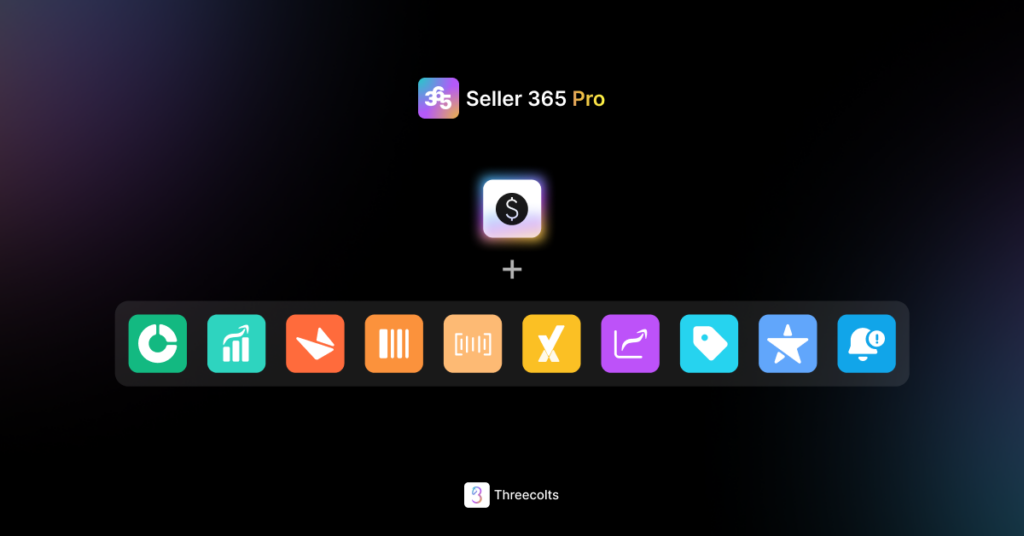- Blog
-
For Sellers
Most Amazon sellers overpay for their tech stack (Here’s how to fix it)
Most sellers don’t realize they’re spending $300+ monthly on tools that barely talk to each other.

Pop quiz: open your credit-card statement and count every SaaS logo tied to your Amazon store. If you hit five logos (or winced before you finished), you’re in crowded company.
The typical FBA seller runs at least five core apps—one for sourcing, one for prep and shipping, one for repricing, one for feedback/alerts automation, and one for profit analytics. Add the odd Chrome extension, and you’re suddenly paying more for software than you did for your first shipment.
Our research puts that starter stack at about $318.99 a month once the free trials vanish. In other words, you’re wiring roughly four grand a year to software vendors before a single box leaves your prep table. The margin squeeze isn’t just platform fees; it’s also the steady drip from overlapping subscriptions.
But that is only the tip of the iceberg. Let’s break down those individual subscriptions one by one to see exactly what a typical seller ends up paying each month.
Don’t feel like reading? Listen to this article in our podcast, Commerce Decoded.
What’s the usual software stack for an Amazon seller?
1. Sourcing and product research: .95 to /month
Finding profitable products is where everything begins—and where the bills start piling up:
- SourceMogul: $97/month
- ArbitrageHero: $47/month
- Scoutly: $9.95 to $35/month, depending on features
- SellerAmp: $19.95 to $27.95/month
- Keepa: $19/month for historical data access
Most sellers combine at least two of these tools. For example, a setup with SourceMogul ($97) and Keepa ($19) already puts you at $116/month just to find products worth selling.
2. Inventory management and shipping: to /month
Once you’ve found products, you need to organize shipments and track inventory:
- Boxem: $49.99 to $69.99/month
- AccelerList: $39.98/month
- Helium10 (Platinum): $39 to $99/month with varying inventory features
Even a mid-tier plan would be around $59/month.
3. Repricing and listing management: .99 to 0/month
The Buy Box is everything on Amazon, making repricing tools non-negotiable:
- ChannelMax: $34.99 to $499.99/month, depending on the number of SKUs
- Seller Snap: $250/month
- GoAura: $97 to $297/month
Even a modest repricing setup will run around $97/month.
4. Feedback and alerts automation: to 9.99/month
Protecting your account health and generating reviews requires dedicated tools:
- Helium10 Follow Up: $99/month (as part of their Platinum plan)
- Sellerboard Autoresponder: $15 to $63/month
- SentryKit: $9.99+/month
- AMZMonitor: $12 to $35/month
- Sellerise: $19.99 to $599.99/month
A seller might use a feedback request automation and seller monitoring tool for a combined $27/month.
5. Profit analytics: to /month
Understanding your true profitability requires specialized tracking:
- Helium10 Profits: $29 to $229/month (as part of larger plans)
- Sellerboard: $19 to $79/month
- Sellerise: $19.99 to $599.99/month
- Shopkeeper: $20 to $250/month
- HelloProfit: $97/month
Opting for a basic profit tracking plan will still cost you around $19/month.
The grand total
Adding up the low end of typical expenses:
- Sourcing: $116/month
- Inventory: $59.99/month
- Repricing: $97/month
- Feedback/Alerts: $27/month
- Profit Analytics: $19/month
Total: $318.99/month or $3,827.88 annually
And that’s just the beginning. As your business grows, you’ll inevitably upgrade to higher tiers, easily pushing your software costs over $500/month.
The hidden costs beyond the subscription fees.
The monthly charges are just what shows up on your credit card statement, though. The real costs run deeper.
Integration headaches
Each tool exists in its own universe. Want your inventory system to talk to your profit analytics? Good luck. You’ll spend hours manually exporting and importing data, introducing errors and delays at every step.
One seller can spend 6 hours every week just transferring data between systems—at $25/hour for their time, that’s an additional $600/month in hidden costs.
The learning curve tax
Every new tool demands time to master. Different interfaces, different logic, different support teams. When you run six different platforms, you’re constantly relearning how to accomplish basic tasks.
Multiple subscriptions = multiple problems
More subscriptions mean:
- More passwords to manage
- More renewal dates to track
- More customer service teams to deal with
- More billing issues to resolve
- More update cycles disrupting your workflow
The all-in-one alternative: Seller 365 at /month.

This fragmented, expensive approach is precisely why we designed an integrated bundle like Seller 365. For just $69/month, Seller 365 includes all 10 essential tools Amazon sellers need:
- Tactical Arbitrage for online arbitrage sourcing
- ScoutIQ for book flipping
- Scoutify for retail arbitrage
- ScoutX for Amazon product research
- InventoryLab for prep and shipping
- SmartRepricer for automated pricing
- FeedbackWhiz Emails for review and feedback requests automation
- FeedbackWhiz Alerts for listing protection and monitoring
- FeedbackWhiz Profits for ASIN-level profit analytics
- InventoryLab Accounting for tax-ready bookkeeping
Each of these tools would cost $30 to 100+ if purchased separately. The math is straightforward: $69 versus $300+ monthly.
Beyond cost savings, there’s the productivity advantage.
The financial savings are obvious, but the bigger advantage comes from having everything in one place.
When all your tools share the same design philosophy, you learn them faster. The skills you develop using one part of Seller 365 transfer to other modules, dramatically reducing the learning curve.
Plus, you also get a support team that understands your entire business. Instead of explaining your issue to five different agents (each with no context about the rest of your business), you get help from people who understand your complete workflow.
Here’s the fix we promised: consolidate everything.
Let’s look at a typical mid-volume Amazon seller before and after consolidating their tech stack:
| Before | After |
|---|---|
| Sourcing: $116/month Inventory management: 59/month Repricing: $97/month Feedback automation: $15/month Alerts tool: $12/month Profit analytics: $19/month Monthly total: $318 Annual cost: $3,816 | Seller 365: $69/month Monthly total: $69 Annual cost: $828 |
Annual Savings: $2,988 in direct costs, plus hours of your time.
And when you consider that every dollar spent on redundant software is a dollar not invested in inventory, PPC advertising, or hiring help, you’d realize just how costly fragmented systems truly are.
Reinvesting your $249 monthly savings into inventory with even a modest 50% ROI would generate an additional $1,494 in profit over a year—enough to cover your entire Seller 365 subscription with money left over.
But the ultimate reason to consolidate your tech stack isn’t just cost savings—it’s focus. Amazon selling is complex enough without managing a dozen different software vendors.
Every minute spent switching between tools, transferring data, or troubleshooting integration issues is a minute not spent on activities that actually grow your business: finding new products, optimizing listings, building supplier relationships, or developing your brand.
When you streamline your technology, you free up mental bandwidth for strategic thinking and execution.
How can you make the transition?
- Start your free trial of Seller 365. Test the platform alongside your existing tools to ensure it meets your needs.
- Migrate one workflow at a time. Begin with your most painful area—perhaps sourcing or repricing—and master that module before moving on.
- Export key data from your existing tools. Pull your historical data, supplier lists, and other critical information to maintain business continuity.
- Cancel subscriptions strategically. Time your cancellations around renewal dates to avoid paying for both systems simultaneously.
- Reinvest your savings. Put the money saved directly into inventory or advertising to accelerate growth.
The math doesn’t lie.
I invite you to do a simple exercise:
- List every software tool you currently use for your Amazon business.
- Write down the monthly cost for each.
- Estimate how many hours you spend managing these tools weekly.
- Multiply that by your hourly value.
- Add the subscription costs and time costs together.
- Compare that total to $69/month for Seller 365.
For most sellers, the results will be eye-opening. The decision becomes less about whether you can afford to switch to an integrated platform, and more about how much longer you can afford not to.
Your Amazon business deserves tools that enhance your profitability, not drain it. In a marketplace where margins matter more than ever, optimizing your tech stack might be the highest-ROI move you make this year.
Ready to stop the subscription drain and take control of your tech stack? Try Seller 365 free for up to 14 days and experience what an integrated, affordable solution can do for your Amazon business.






















